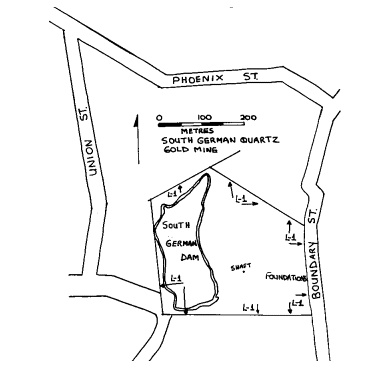SOUTH GERMAN QUARTZ GOLD MINE
SOUTH GERMAN ROAD MALDON, MOUNT ALEXANDER SHIRE
-
Add to tour
You must log in to do that.
-
Share
-
Shortlist place
You must log in to do that.
- Download report




Statement of Significance
The Maldon Quartz Reefing Field, although relatively small compared to others in the State, was extraordinary rich in gold. The hardness and heavy mineralisation of the rock containing the gold placed Maldon's mining companies in the vanguard for the installation and use of new technology. The South German Company began its mining career in the mid 1870s with the installation of steam-powered pumping and hauling plant. In 1886, its confidence increasing, the company erected a 20-head stamp battery, which was later increased to 30-head. In 1887, the company constructed pyrites ovens for burning the battery sand, preparatory to gold extraction. In the 1890s, the South German mine became one of the largest producers of gold in Victoria and was of great importance to the social and economic condition of Maldon.
Towards the end of the century, the mine's production began to falter. To counter the decline, in 1897 an extensive re-treatment plant was installed, using the cyanide process to extract gold from tailings (waste battery sand). The company's pioneering use of the process was stunningly successful, resulting in the retrieval of as much gold from the discarded tailings as had already been obtained by crushing and the usual gold separation processes. In 1902 the South German Company lost the shoot of gold that had provided the bulk of its ore from 1886. Up to 1902, the company had paid £336,600 in dividends to shareholders; they were to receive little more as the company searched in vain for a continuation of the shoot. The mine was closed in 1918 when the shaft was flooded with water.
The South German Quartz Gold Mine is of historical, archaeological and scientific importance to the State of Victoria.
The South German Quartz Gold Mine is historically and scientifically important as a characteristic example of an important form of gold mining. Gold mining sites are of crucial importance for the pivotal role they have played since 1851 in the development of Victoria. As well as being a significant producer of Victoria's nineteenth century wealth, quartz mining, with its intensive reliance on machinery, played an important role in the development of Victorian manufacturing industry. The South German Quartz Gold Mine is important as a manifestation of this aspect of gold mining. The South German mine site is historically significant due to its role in pioneering the use of the cyanide process in Victoria. Its treatment works was extremely profitable and influenced many other companies to adopt the process. The South German Company used a cyaniding system which was invented and patented by JJ Deeble of Bendigo. This system was to become widely used both in Australia and overseas.
The South German Quartz Gold Mine is also significant for its potential to yield artefacts and evidence which will be able to provide information about the technological history of gold mining.
-
-
SOUTH GERMAN QUARTZ GOLD MINE - Permit Exemptions
General Exemptions:General exemptions apply to all places and objects included in the Victorian Heritage Register (VHR). General exemptions have been designed to allow everyday activities, maintenance and changes to your property, which don’t harm its cultural heritage significance, to proceed without the need to obtain approvals under the Heritage Act 2017.Places of worship: In some circumstances, you can alter a place of worship to accommodate religious practices without a permit, but you must notify the Executive Director of Heritage Victoria before you start the works or activities at least 20 business days before the works or activities are to commence.Subdivision/consolidation: Permit exemptions exist for some subdivisions and consolidations. If the subdivision or consolidation is in accordance with a planning permit granted under Part 4 of the Planning and Environment Act 1987 and the application for the planning permit was referred to the Executive Director of Heritage Victoria as a determining referral authority, a permit is not required.Specific exemptions may also apply to your registered place or object. If applicable, these are listed below. Specific exemptions are tailored to the conservation and management needs of an individual registered place or object and set out works and activities that are exempt from the requirements of a permit. Specific exemptions prevail if they conflict with general exemptions. Find out more about heritage permit exemptions here.Specific Exemptions:EXEMPTIONS FROM PERMITS:
(Classes of works or activities which may be undertaken without a permit under
Part 4 of the Heritage Act 1995)
No permits are required for the following classes of works provided they are
carried out in accordance with the provisions of the Conservation Plan For
Historic Mining Sites prepared by David Bannear in 1996.
Mineral Exploration
Fire suppression duties
Timber production
Weed and vermin control
Public safety
Rehabilitation
-
-
-
-
-
FORMER ROYAL HOTEL AND THEATRE
 Victorian Heritage Register H1391
Victorian Heritage Register H1391 -
LAURISTON
 Victorian Heritage Register H1421
Victorian Heritage Register H1421 -
FORMER MARKET HALL AND ROYAL OAKS
 Victorian Heritage Register H1390
Victorian Heritage Register H1390
-
'Boonderoo', House and Outbuildings
 Greater Bendigo City
Greater Bendigo City -
'Riverslea' house
 Greater Bendigo City
Greater Bendigo City -
1 Adam Street
 Yarra City
Yarra City
-
-












